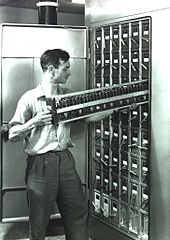 EDSAC 2 users in 1960 | |
| Developer | University of Cambridge, Mathematical Laboratory, UK |
|---|---|
| Release date | 1958 |
| Lifespan | Decommissioned 1965 |
| CPU | 20-bit instructions with 11-bit addresses, two index registers, microcoded; @ fixed point add: 17–42 microseconds, floating point add: 100–170 microseconds[1] |
| Memory | 1024 words RAM, 768 words ROM[1] (core memory, 40-bit words) |
| Storage | block-structured magnetic tape, 16K words, core memory, added in 1962[1] |
| Input | 5-level paper tape, up to 1000 characters per second read, 300 cps punched output, two-out-of-five code[1] |
| Predecessor | EDSAC |
EDSAC 2 was an early vacuum tube computer (operational in 1958), the successor to the Electronic Delay Storage Automatic Calculator (EDSAC). It was the first computer to have a microprogrammed control unit and a bit-slice hardware architecture.[1]

First calculations were performed on the incomplete machine in 1957.[2] Calculations about elliptic curves performed on EDSAC-2 in the early 1960s led to the Birch and Swinnerton-Dyer conjecture, a Millennium Prize Problem, unsolved as of 2024. And in 1963, Frederick Vine and Drummond Matthews used EDSAC 2 to generate a magnetic anomaly map of the seafloor from data collected in the Indian Ocean by H.M.S. Owen, key evidence that helped support the theory of plate tectonics.[3] EDSAC-2 was decommissioned in 1965, having been superseded by the Titan computer.[4]
- ^ a b c d e Wilkes, M.V. (1992). "EDSAC 2". IEEE Annals of the History of Computing. 14 (4). PDF available by "View PDF" (expand "View on IEEE"): 49–56. doi:10.1109/85.194055. S2CID 11377060.
- ^ "New computer in Cambridge". New Scientist. Reed Business Information. 8 August 1957. p. 31.
- ^ Vine, Fred J.; Matthews, Drummond H. (1963). "Magnetic anomalies over oceanic ridges". Nature. 199 (4897): 947–949. Bibcode:1963Natur.199..947V. doi:10.1038/199947a0. S2CID 4296143.
- ^ "EDSAC II Arithmetic Unit – Computer". computinghistory.org.uk. UK: Computing History. Retrieved 14 August 2024.
